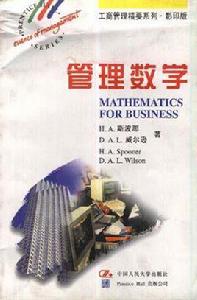內容介紹
為什麼要在管理活動中運用數學方法?怎樣理解各種圖表和數據?什麼是數學模型?怎樣運用數學模型輔助解決管理中的難題?本書對上述問題及其他有關問題作了清楚而確切的解釋。
作品目錄
Contents
1 EIementary algebra
Introduction
1.1 Algebraic expressions and equations
1.2 The addition and subtraction of algebraic forms
1.3 Products of positive and negative real numbers
1.4 Expansion of bracketed terms
1.5 Fractions
1.6 Exponents
1.7 Negative exponents
1.8 Cancelling out tenms
1.9 The order and hierarchy of operations
1.10 Factorization
1.11 Degree of an expression
1.12 Perfect squares
1.13 Applications
Additional examples
2 Solving equations
Introduction
2.1 Drawing graphs
2.2 Straight-line or linear functions
2.3 Quadratic functions
2.4 Cubic functions
2.5 Algebraic solution of equations
2.6 Equations involving fractions
2.7 Quadratic equations
2.8 Formula for solving quadratic equations
2.9 Solution of cubic equations
2.10 Applications
Additional examples
3 Simultaneous equations and inequalities
Introduction
3.1 Simple equations with one variable
3.2 Pairs of equations
3.3 Using a set of equations as a model
3.4 Sets of three or more equations
3.5 Independent and dependent equations
3.6 Linear and non-linear equations
3.7 Inequalities
3.8 Simultaneous inequalities
3.9 Applications of inequalities
Additional examples
4 Series
Introduction
4.1 Arithmetic progression (AP)
4.2 The sigma notation for summation
4.3 Sum of terms of an AP
4.4 Geometric progression (GP)
4.5 Sum of terms of a GP
4.6 Notation for interest calculations
4.7 Compound interest
Additional examples
5 Logarithms and exponentials
Introduction
5.1 Logarithms and exponents
5.2 How logarithms work
5.3 Rules for combining logarithms
5.4 The exponential function and continuous compounding
5.5 Nominal interest rates and effective interest rates
5.6 Negative growth
5.7 Application
Additional examples
6 Matrices
Introduction
6.1 Matrix notafion
6.2 Equality, addition and subtraction of matrices
6.3 Multiplication of matrices
6.4 Transposing matrices
6.5 Matrix formulation of simultaneous equations
6.6 The identity matrix and the inverse
6.7 Determinants
6.8 The inverse of a 2 x 2 matrix
6.9 Summary
Additional examples
7 Differentiation
Introduction
7.1 The slope of a straight line
7.2 Finding the equation of a straight line
7.3 A numerical method for finding the slope of a curve
7.4 The general method of differentiation
7.5 Rules for derivatives
7.6 The derivative of the redprocal of a function
Additional examples
8 More about ditterentiation
Introduction
8.1 The second and higher derivatives
8.2 Alternative notation for the derivative
8.3 Maxima and minima
8.4 Points of inflexion
8.5 The function of a function rule
8.6 The product rule
8.7 Mixing the function of a function and product rules
8.8 Differentiating expressions containing fractions
8.9 Continuous functions
8.10 Partial derivatives
Additional examples
9 Integration
Introduction
9.1 Integration as the reverse of differentiation
9.2 Rules for integration
9.3 The definite integral
9.4 The integral as the area between the curve and the x-axis
9.5 A general remark on integration and differentiation
Additional examples
10 The application ofmathematics
10.1 Mathematical style
10.2 Taclding mathematical examination questions
10.3 Formulating real-life problems
10.4 Solving real-life problems
Appendix The Greek alphabet
Solutions to additional examples

